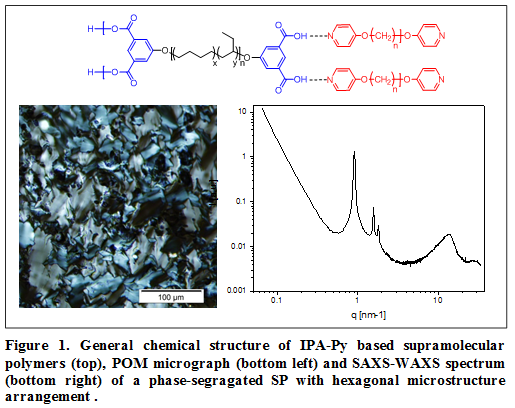The effect of hard phase crystallization on the microphase segregation of supramolecular polymers
Supramolecular polymers (SPs) are macromolecular assemblies of monomeric units, which are connected by reversible and directional non-covalent interactions such as H-bonding, metal-ligand complexation and π-π stacking.1 SPs are typically synthesized via the functionalization of telechelic oligomers with supramolecular units (e.g. hydrogen bonding groups) at the chain ends. The assembly of the resulting macromonomers through chain-end interactions affords supramolecular polymers with apparent molecular weights that are dictated by the corresponding association constant. Chain-extension is often accompanied by microphase segregation into two phases that are formed by the supramolecular motifs and the telechelic cores, respectively. In many cases the latter displays a low glass transition temperature, whereas the former constitutes a crystalline hard phase that provides physical cross-links. As a result, such SPs display elastomer-like properties. While the mechanical properties of such phase segregated SPs are well established, the role of the crystalline phase on their microstructure is less well investigated.
A new class of phase segregated SPs based on the isophthalic acid-pyridine (IPA-Py) H-bonding motif was recently reported.2 These SPs are synthesized by mixing two components, a telechelic poly(ethylene-co-butylene) terminated with isophthalic acid units and a bipyridine (Figure 1). In these SPs, the hard phase is formed by the crystallization of the IPA-Py motifs, and the properties of the hard phase can be controlled by simple variation of the bipyridine component. In this contribution we report the results of an experimental study in which the influence of the hard phase’s composition on the microstructure of IPA-Py-based SPs was explored. Through the combination of small angle X-ray scattering (SAXS), electron microscopy (TEM), thermal and thermomechanical analyses, we discovered that very subtle changes in the hard phase composition can cause considerable changes of the SPs’ morphology. Temperature-dependent SAXS studies revealed that most of these SPs feature a hexagonal microstructure arrangement above the melting temperature of the hard phase. However, when cooled from the melt, the observed mesophase is either retained or lost, depending on the nature of the bipyridine component. The results show strikingly that the crystalline structure of the hard phase has a strong influence on the phase behaviour of nanophase-segregated SPs.

[1] Luc Brunsveld, Brigitte J.B Folmer, Egbert Willem Meijer, Rint P. Sijbesma, Chemical Reviews, 2001, 101 (12), 4071–4097.
[2] Lucas Montero De Espinosa, Sandor Balog, Christoph Weder, ACS Macro Letters, 2014, 3 (6), 540–543.